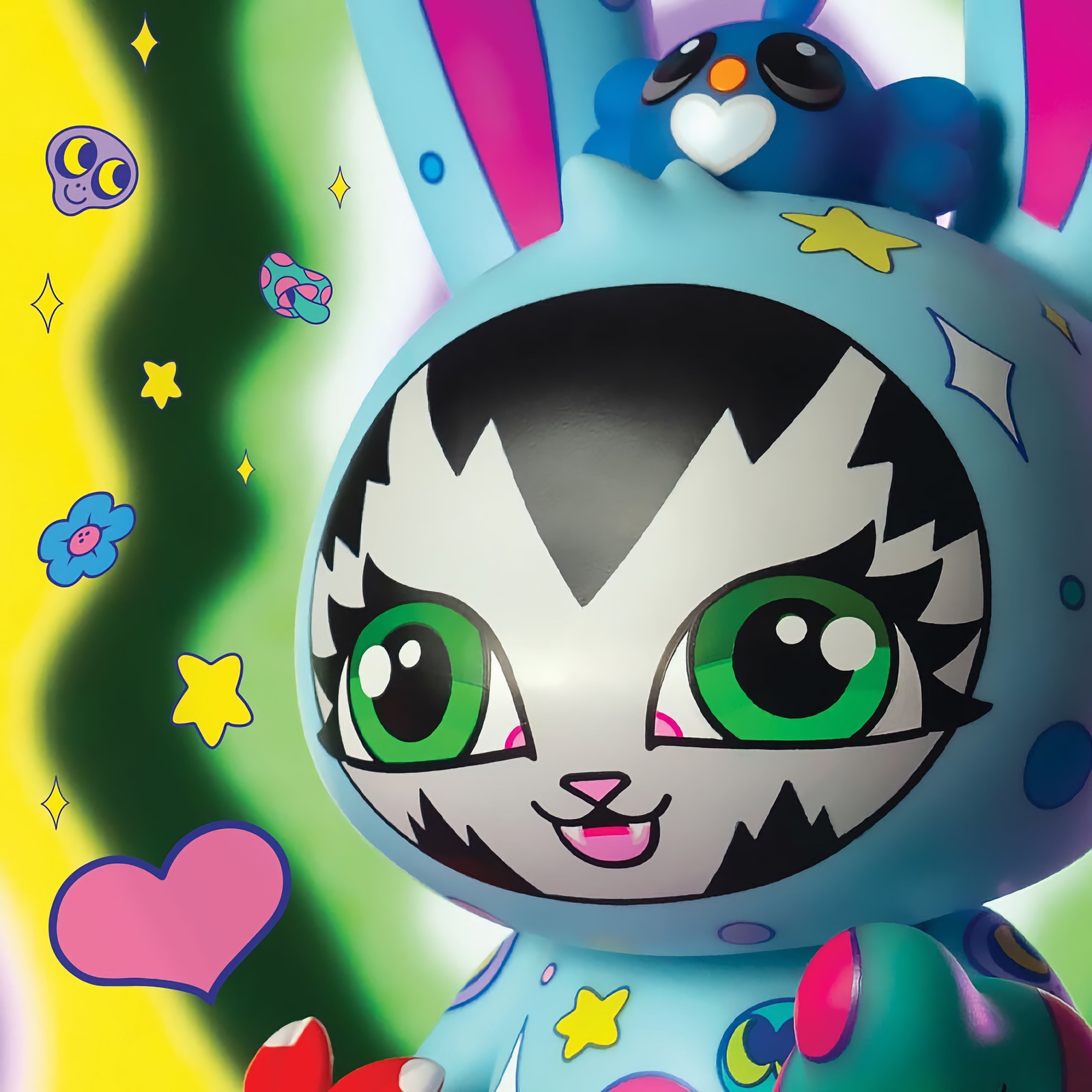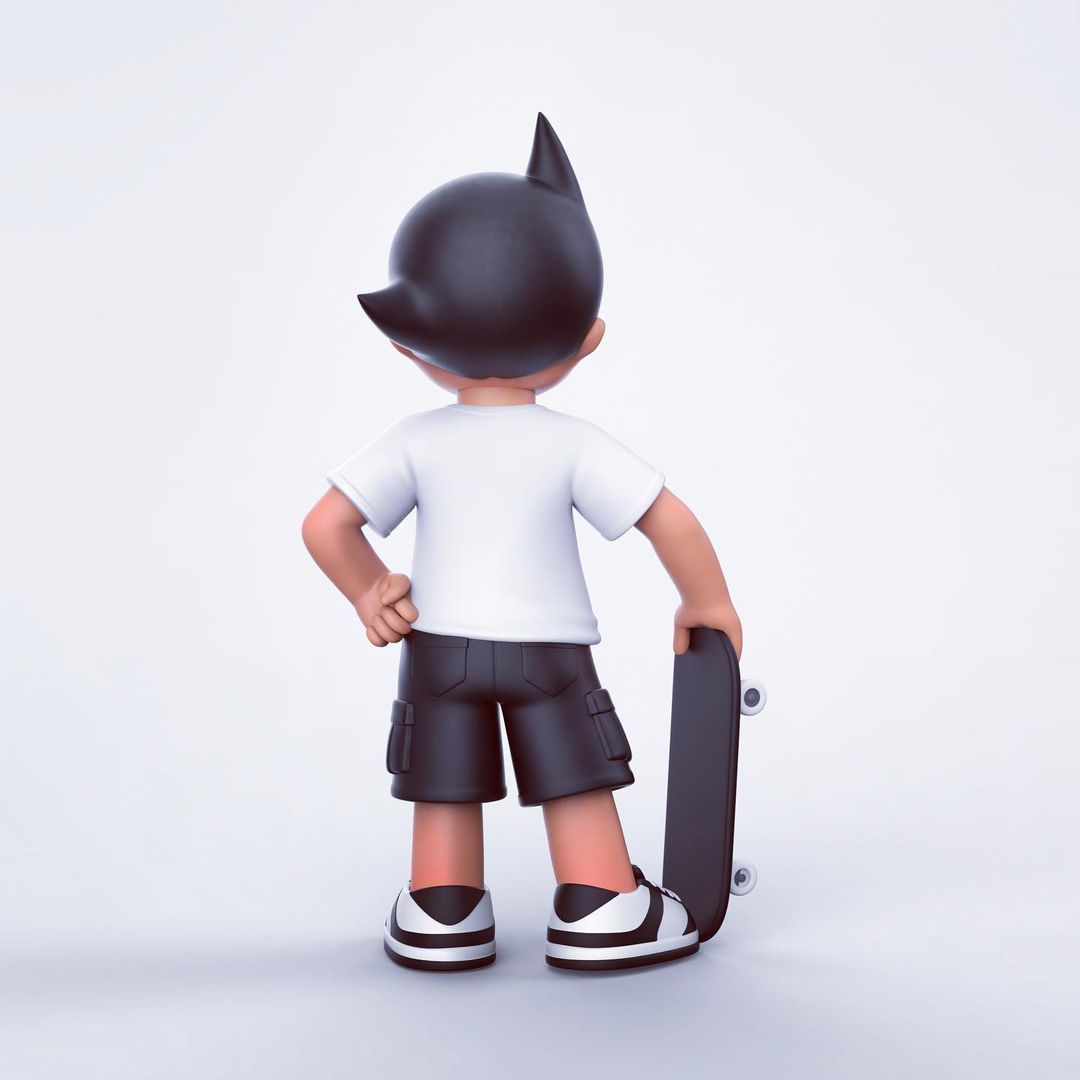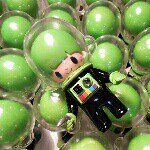Today we’re bringing you an exclusive first look (turn-arounds) at Julie West’s first original vinyl figures, Bumble (above) and Tweet (below), currently in production from STRANGEco. Over the next several months we’ll be bringing you updates on the development process through all the key stages — sculpting and revisions, color samples and revisions, packaging, and the finished product. Each update will feature commentary by both Julie and STRANGEco’s production team.
Julie West has exhibited her art in numerous group shows around the world. Whether on a 2D surface or on a 3D toy, her characters bring a unique aesthetic driven by her signature rendering of facial features. Her customs are remarkably well-executed with crisp, immaculate lines. Here’s Julie’s take on the initial design process for her upcoming vinyl figures, the release of which ( ~ August ’08) will likely result in the widest audience for her personal art to-date.
Julie: The characters are an extension of ideas and themes that I use in
my regular work – a 3d version of what I typically do in 2d. I tend to
draw a lot of birds (especially birds) and bees along side human
characters and they are really prevalent in my work.
When approaching the toys, I wanted to make them in a manner that
they could be played with or displayed in different ways. This is why
they have multiple parts that you can take off and move around. The bees and birds will be magnetic and will stick to various parts on the bird house and bees nest so my hope is that people play with them 🙂
The general idea for the toys was one I had for months before I spoke
with Gregory [STRANGEco] about making them. So in some ways – a lot had been worked
out before I ever put pencil to paper. However, this is true with my
2d work as well. I tend to think about things for a week or two before
I ever draw anything, so it’s usually pretty close to how I imagined it.
I did sort of do rough sketches first. They
changed a bit (they are shorter and had necks 😉 ) It was quite a leap
between those initial sketches and the turnarounds. This is simply due
to the fact that I had a bit of time to think about them and when I sat
down to work on them again, I had a much clearer picture in my mind of
what I wanted and how they would work.
It was interesting in this case, as I was actually making the shape as well as the design for the toys. I did not have much experience making turn-arounds for objects, so it took a bit of effort on my part to think of them in 3d. That said, I think that they turned out really well – after various comments from Emily and Gregory [STRANGEco] that helped me to see how things would "actually look." During the sketch stage they helped with some bits
that I wasn’t really sure about – for instance some parts are affected
by the manufacturing process – how the head sits on the body, if the
arms move or not, how the "hats" sit on the head without falling off
for example 🙂 For the most part though, they were willing to let me do
what I wanted and see what the factory came back with later as far as
necessary changes.
Creating an original vinyl figure is a collaborative process between the artist and the toy company’s production team. The genesis of this project may have started simply enough — Julie added STRANGEco as a Flickr contact, at which point company co-founder and production guru Gregory Blum took a look at her work and liked what he saw. Once production manager Emily Brough mentioned that Julie’s art would be a strong fit for a toy, the company approached her. After a successful and lengthy phone conversation exploring the types of toys to make for their first collaboration (size, features, price point, quantity) as well as engineering issues affecting a finished product’s price and accessibility, the next step was for Julie to present an initial design. For a detailed description of STRANGEco’s role in the figure design process we turn things over to Gregory.
Gregory Blum: After
that [phone meeting], we let her work on designs on her own to show us when she
was comfortable with them. This is key to how STRANGEco works: we
select the artists to work with because we like their art, and then
strive to realize a faithful sculptural interpretation of their 2D
work. We are involved in design development in each project –
suggesting potential subjects, additions or modifications to design
that might add to it functionally or aesthetically, etc,, but we try
not to get in the way of the artist’s design process. This usually
results in a truly unique piece that the artist feels is an example of
their work. This is exciting and fulfilling to us – much more so than
having an artist apply their style and technique to a pre-existing
product or object.
Julie rocked it
with her initial turnarounds and decoration ideas. Everything was very
practical, and required very few revisions. We went back and forth
about a few issues, like the approach to constructing the face, limb
articulation, hats and other accessories, and collaboratively decided
on the ideal directions. Julie had a lot of different color/decoration
mock ups – and they were all very appealing (if it were practical, we’d
have about 20 different colorways!). We selected a range of color and
deco that we felt was varied enough to appeal to a wide audience –
sometime a combination of a few designs. Julie reworked some designs
to accommodate our comments while suiting her style, and I think we
have a really nice line-up selected. We may have to make
some compromises to one of the versions due to a technical issue, but
we’ll have to wait til the molds are done and the factory engineers
can assess the practicality.
[Next up: The sculpting for Bumble and Tweet in about 2 to 3 weeks].










